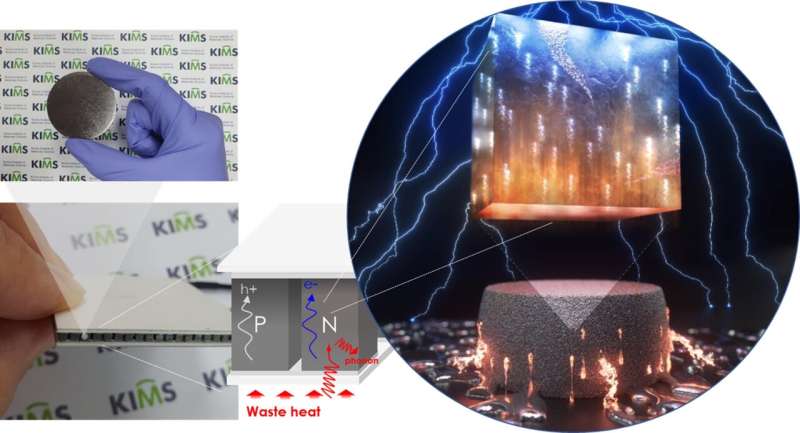
October 14, 2024 by National Research Council of Science and Technology
Collected at: https://techxplore.com/news/2024-10-team-key-thermoelectric-semiconductor-technology.html
A research team has developed a bismuth telluride (Bi-Te) based thermoelectric material with artificially formed atomic-scale defects and proposed a solution to improve its properties in order to harness wasted thermal energy. This is a semiconductor technology applied to thermoelectric power generators that generate electricity by recycling waste heat below 200℃ from industrial and transportation sectors such as factories, automobiles, and ship engines. Thermoelectric power generators are a combination of p-type and n-type semiconductors that reversibly convert temperature differences into electrical energy and vice versa.
Until now, research has focused on improving the properties of p-type thermoelectric materials composed of bismuth (Bi) and tellurium (Te). On the other hand, n-type thermoelectric semiconductors containing selenium (Se) have been slow to improve their properties due to the difficulty in controlling the composition and microstructure, which has been pointed out as a hindrance to the commercialization of thermoelectric technology.
The research team focused on n-type thermoelectric semiconductors, which determine the performance of thermoelectric power generators, and made a breakthrough that has been stalled for decades. The key to the breakthrough lies in the doping material and manufacturing process. The study is published in the journal ACS Applied Materials & Interfaces.
Doping materials are elements that are added to improve the electrical conductivity of a semiconductor. Recognizing that p-type bismuth telluride with antimony (Sb) as a doping material are likely to achieve optimal performance, the team developed an n-type material that incorporates antimony (Sb) instead of selenium (Se), which is commonly used as a doping material for n-type bismuth telluride.

The team also developed a method to artificially induce “atomic defects” that promote electron formation and “dislocation networks” that scatter the transfer of lattice phonons, a heat transfer medium, during the fabrication process of n-type thermoelectric materials, resulting in higher electrical conductivity and lower thermal conductivity. The technology uses a powder metallurgy route that is placed in a mold, heated, and then sintered, making it easy to manufacture thermoelectric materials in the designed shape and size.
The n-type thermoelectric semiconductor developed through this technology clearly exhibits the thermal and electrical properties required for thermoelectric devices, such as more than doubling the electrical conductivity while decreasing the thermal conductivity. In particular, the team’s thermoelectric technology, which boasts excellent energy conversion performance and allows for easy material combination, is expected to be applied to recycling heat at around 200℃ at room temperature, including human body heat.
The thermoelectric power generator market is growing at a CAGR of 8.2% and is expected to reach $1.18 billion globally by 2029. The research team is currently developing a thermoelectric power plant in collaboration with LIVINGCARE Co., Ltd. In addition, the team is conducting a fundamental study for a power generation system to recover waste heat generated from casting molds through cooperation with Hyundai Motor Company’s Ulsan plant.
Dr. Kyung Tae Kim, who is leading this research, said, “This study has laid a stepping stone to solving the property control of n-type thermoelectric semiconductor, which has been an obstacle to recycling various types of waste heat below 200℃.
“The significance lies in the development of nanostructured thermoelectric material technology with controlled atomic-level defects using traditional powder metallurgy technology.”
More information: Soo-ho Jung et al, Synergistic Tailoring of Electronic and Thermal Transports in Thermoelectric Se-Free n-Type (Bi,Sb)2Te3, ACS Applied Materials & Interfaces (2024). DOI: 10.1021/acsami.4c06978
Journal information: ACS Applied Materials and Interfaces

Leave a Reply